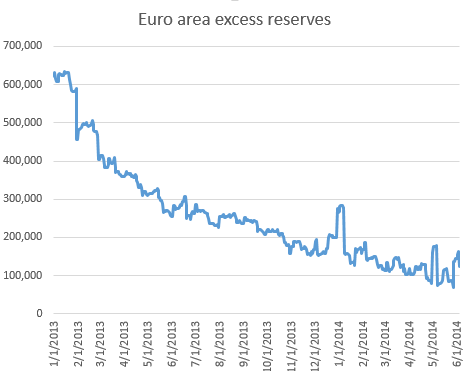I’ve cut through some of the media noise on today’s action form the ECB. Here are a few points worth discussing.
1. The negative rate on deposits would have been far more effective a couple of years ago when the Eurozone banks’ excess reserves were a multiple of what they are now.

2. The end of sterilization of the SMP portfolio, bonds that the ECB had purchased a few years back (see discussion from Feb), will provide a boost to excess reserves. The current SMP balance is about €165bn – which is material relative to current excess reserve levels. Additional excess reserves will make the negative rate policy more effective.
3. The negative rate on deposits is sending banks into short-term periphery paper, as yields compress further.
 |
| Spain’s 1y government bond yield (source: Investing.com) |
It’s important to note that excess reserves are a bit like a hot potato – you can pass them from bank to bank, but at the end of the day someone always gets stuck with them. That means some euro area banks will be making payments to the ECB of 0.1% on deposits. The Germans were quite upset about this – they feel that as far as their country is concerned the action will do more harm than good (see story).
4. The cut in ECB’s main financing rate is basically symbolic. The problem with this near-zero rate is that if the ECB could set a separate rate for Germany vs. the rest of the member states, these rates would have been dramatically different. The so-called Taylor Rule, which models the “appropriate” interest rate, produces the following result.
 |
| Source: CIBC |
This high discrepancy maintains tight conditions in “EZ ex-Germany”, while risking asset bubbles in Germany due to a highly accommodate policy there. Here is an example.
 |
| Germany;Â Residential property prices, New and existing dwellings; Residential property in good & poor condition; Whole country (source: ECB) |

